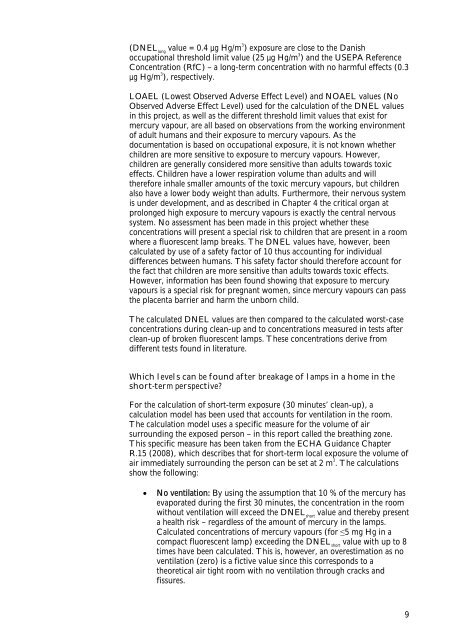No. 104 - Miljøstyrelsen
No. 104 - Miljøstyrelsen
No. 104 - Miljøstyrelsen
Create successful ePaper yourself
Turn your PDF publications into a flip-book with our unique Google optimized e-Paper software.
(DNEL value = 0.4 µg Hg/m long 3<br />
) exposure are close to the Danish<br />
occupational threshold limit value (25 µg Hg/m 3<br />
) and the USEPA Reference<br />
Concentration (RfC) – a long-term concentration with no harmful effects (0.3<br />
µg Hg/m 3<br />
), respectively.<br />
LOAEL (Lowest Observed Adverse Effect Level) and NOAEL values (<strong>No</strong><br />
Observed Adverse Effect Level) used for the calculation of the DNEL values<br />
in this project, as well as the different threshold limit values that exist for<br />
mercury vapour, are all based on observations from the working environment<br />
of adult humans and their exposure to mercury vapours. As the<br />
documentation is based on occupational exposure, it is not known whether<br />
children are more sensitive to exposure to mercury vapours. However,<br />
children are generally considered more sensitive than adults towards toxic<br />
effects. Children have a lower respiration volume than adults and will<br />
therefore inhale smaller amounts of the toxic mercury vapours, but children<br />
also have a lower body weight than adults. Furthermore, their nervous system<br />
is under development, and as described in Chapter 4 the critical organ at<br />
prolonged high exposure to mercury vapours is exactly the central nervous<br />
system. <strong>No</strong> assessment has been made in this project whether these<br />
concentrations will present a special risk to children that are present in a room<br />
where a fluorescent lamp breaks. The DNEL values have, however, been<br />
calculated by use of a safety factor of 10 thus accounting for individual<br />
differences between humans. This safety factor should therefore account for<br />
the fact that children are more sensitive than adults towards toxic effects.<br />
However, information has been found showing that exposure to mercury<br />
vapours is a special risk for pregnant women, since mercury vapours can pass<br />
the placenta barrier and harm the unborn child.<br />
The calculated DNEL values are then compared to the calculated worst-case<br />
concentrations during clean-up and to concentrations measured in tests after<br />
clean-up of broken fluorescent lamps. These concentrations derive from<br />
different tests found in literature.<br />
Which levels can be found after breakage of lamps in a home in the<br />
short-term perspective?<br />
For the calculation of short-term exposure (30 minutes’ clean-up), a<br />
calculation model has been used that accounts for ventilation in the room.<br />
The calculation model uses a specific measure for the volume of air<br />
surrounding the exposed person – in this report called the breathing zone.<br />
This specific measure has been taken from the ECHA Guidance Chapter<br />
R.15 (2008), which describes that for short-term local exposure the volume of<br />
air immediately surrounding the person can be set at 2 m 3<br />
. The calculations<br />
show the following:<br />
� <strong>No</strong> ventilation: By using the assumption that 10 % of the mercury has<br />
evaporated during the first 30 minutes, the concentration in the room<br />
without ventilation will exceed the DNEL short value and thereby present<br />
a health risk – regardless of the amount of mercury in the lamps.<br />
Calculated concentrations of mercury vapours (for ≤5 mg Hg in a<br />
compact fluorescent lamp) exceeding the DNEL short value with up to 8<br />
times have been calculated. This is, however, an overestimation as no<br />
ventilation (zero) is a fictive value since this corresponds to a<br />
theoretical air tight room with no ventilation through cracks and<br />
fissures.<br />
9

















